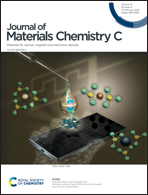Novel CuBr-assisted graphdiyne synthesis strategy and application for efficient photocatalytic hydrogen evolution†
Abstract
Graphdiyne (GDY), a new allotrope of carbon, also has a higher potential in photocatalysis due to its narrow bandgap and high electron–hole mobility. For the first time, a GDY–CuBr composite with high hydrogen evolution performance was synthesized using CuBr as a catalytic substrate rather than copper foil in this work. GDY–CuBr exhibits clearly superior activity when compared to the GDY–CuI catalyst synthesized with CuI as the substrate. Washing with ammonia water several times to remove CuBr yields relatively pure GDY. Triethanolamine (TEOA) was used as the sacrificial reagent and Eosin-Y as the sensitizer. When compared to CuBr as the catalytic substrate, the photocatalytic hydrogen evolution performance of GDY–CuBr was three times stronger. The improved hydrogen production activity of GDY–CuBr in the Eosin-Y (EY) sensitization system can be attributed to GDY's unique pore structure, which encourages the adsorption of EY molecules. Furthermore, the p–n heterojunction formed between CuBr and GDY effectively promotes the charge transfer in the system. This work is a good starting point for investigating and extending the possible synthesis and applications of GDY materials in the field of photocatalysis.



 Please wait while we load your content...
Please wait while we load your content...